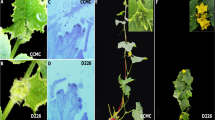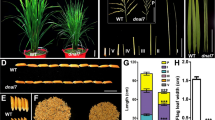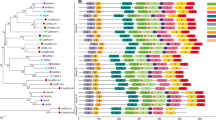Abstract
Key message
Two genetic loci, det-ma (CsCEN) and det-lb, showed epistatic interaction on indeterminate/determinate growth of LB in cucumber. CsSHBY was identified as the candidate gene for det-lb locus.
Abstract
Plant architecture depends on the spatial regulation of meristems from both main axis (MA) and lateral branches (LBs). Fate (indeterminate or determinate) of these meristems is a crucial source of architectural diversity determining crop productivity and management. CENTRORADIALIS/TERMINAL FLOWER 1/SELF-PRUNING (CETS) gene family have been well known as pivotal regulators for indeterminate/determinate growth of MA. Nevertheless, genes that regulate LB indeterminacy/determinacy remained unclear. Cucumber (Cucumis sativus L.) has typical monopodial growth and multiple lateral branches. Both MA and LBs had indeterminate or determinate growth, and indeterminate/determinate growth of LB was controlled by two distinct loci, det-ma (CsCEN) and det-lb. In our study, based on bulked segregant analysis (BSA) method, the det-lb locus was mapped on a 60.6 kb region on chromosome 1 harboring only one gene CsaV3_1G044330, which encoded a putative vacuolar-sorting protein (designated as CsSHBY). Multipoint mutations in CsSHBY were identified in D082 and D226, compared with CCMC, including nonsynonymous SNP mutations and a 6-bp deletion in exons. Further, qPCR showed that CsSHBY was highly expressed in lateral bud of CCMC, suggesting that CsSHBY might play an active role in regulating indeterminate/determinate growth of LB. Genetic analyses showed that det-ma (CsCEN) had an epistatic effect on det-lb (CsSHBY), and CsCEN could activate CsSHBY promoter by Dual luciferase and GUS activity assays. Meanwhile, Cscen or Csshby was found to influence auxin contents and CsYUCs and CsPINs expression levels. These findings provided new insights into precisely optimizing plant architecture for yield improvements.






Similar content being viewed by others
Data availability
All data generated or analyzed during this study are included as supplementary materials.
References
Adamowski M, Friml J (2015) PIN-dependent auxin transport: action, regulation, and evolution. Plant Cell 27:20–32
Aguilar-Martínez JA, Poza-Carrión C, Cubas P (2007) Arabidopsis branched1 acts as an integrator of branching signals within axillary buds. Plant Cell 19:458–472
Bennett T, Hines G, Van Rongen M, Waldie T, Sawchuk MG, Scarpella E, Ljung K, Leyser O (2016) Connective auxin transport in the shoot facilitates communication between shoot apices. PLoS Biol 14:e1002446
Bradley D, Carpenter R, Copsey L, Vincent C, Rothstein S, Coen E (1996) Control of inflorescence architecture in Antirrhinum. Nature 379:791–797
Bradley D, Ratcliffe O, Vincent C, Carpenter R, Coen E (1997) Inflorescence commitment and architecture in Arabidopsis. Science 275:80–83
Cazzonelli CI, Vanstraelen M, Simon S, Yin K, Carron-Arthur A, Nisar N, Tarle G, Cuttriss AJ, Searle LR, Benkova E, Mathesius U, Masle J, Friml J, Pogson BJ (2013) Role of the Arabidopsis PIN6 auxin transporter in auxin homeostasis and auxin-mediated development. PLoS One 8:e70069
Chen W, Yao J, Li Y, Zhao L, Liu J, Guo Y, Wang J, Li Y, Liu Z, Lu Y, Zhang Y (2019) Nulliplex-branch, a Terminal flower 1 ortholog, controls plant growth habit in cotton. Theor Appl Genet 132:97–112
Cheng X, Li G, Tang Y, Wen J (2018) Dissection of genetic regulation of compound inflorescence development in Medicago truncatula. Development 145:dev158766
Clough SJ, Bent AF (1998) Floral dip: a simplified method for Agrobacterium-mediated transformation of Arabidopsis thaliana. Plant J 16:735–743
Conti L, Bradley D (2007) Terminal flower 1 is a mobile signal controlling Arabidopsis architecture. Plant Cell 19:767–778
Domagalska MA, Leyser O (2011) Signal integration in the control of shoot branching. Nat Rev Mol Cell Bio 12:211–221
Dou J, Wang Y, Yang H, Niu H, Liu D, Yang S, Zhu H, Sun S, Yang L (2022) Development of branchless watermelon near isogenic lines by marker assisted selection. Hortic Plant J 8:627–636
Foucher F, Morin J, Courtiade J, Cadioux S, Ellis N, Banfield MJ, Rameau C (2003) Determinate and late flowering are two terminal flower 1/Centroradialis homologs that control two distinct phases of flowering initiation and development in pea. Plant Cell 15:2742–2754
Galli M, Gallavotti A (2016) Expanding the regulatory network for meristem size in plants. Trends Genet 32:372–383
Greb T, Clarenz O, Schafer E, Muller D, Herrero R, Schmitz G, Theres K (2003) Molecular analysis of the Lateral Suppressor gene in Arabidopsis reveals a conserved control mechanism for axillary meristem formation. Gene Dev 17:1175–1187
Hanano S, Goto K (2011) Arabidopsis terminal flower 1 is involved in the regulation of flowering time and inflorescence development through transcriptional repression. Plant Cell 23:3172–3184
Hellens RP, Allan AC, Friel EN, Bolitho K, Grafton K, Templeton MD, Karunairetnam S, Gleave AP, Laing WA (2005) Transient expression vectors for functional genomics, quantification of promoter activity and RNA silencing in plants. Plant Methods 1:13
Hubbard L, McSteen P, Doebley J, Hake S (2002) Expression patterns and mutant phenotype of teosinte branched1 correlate with growth suppression in maize and teosinte. Genetics 162:1927–1935
Jefferson RA, Kavanagh TA, Bevan MW (1987) GUS fusions: beta-glucuronidase as a sensitive and versatile gene fusion marker in higher plants. EMBO J 6:3901–3907
Keller T, Abbott J, Moritz T, Doerner P (2006) Arabidopsis regulator of axillary meristems1 Controls a leaf axil stem cell niche and modulates vegetative development. Plant Cell 18:598–611
Koizumi K, Gallagher KL (2013) Identification of shrubby, a short-root and scarecrow interacting protein that controls root growth and radial patterning. Development 140:1292–1300
Liu B, Watanabe S, Uchiyama T, Kong F, Kanazawa A, Xia Z, Nagamatsu A, Arai M, Yamada T, Kitamura K, Masuta C, Harada K, Abe J (2010) The soybean stem growth habit gene Dt1 is an ortholog of arabidopsis terminal flower1. Plant Physiol 153:198–210
Livak KJ, Schmittgen TD (2001) Analysis of relative gene expression data using real-time quantitative PCR and the 2(-delta delta C(T)) method. Methods 25:402–408
Ljung K, Bhalerao RP, Sandberg G (2001) Sites and homeostatic control of auxin biosynthesis in Arabidopsis during vegetative growth. Plant J 28:465–474
Lucas M, Swarup R, Paponov IA, Swarup K, Casimiro I, Lake D, Peret B, Zappala S, Maithofer S, Whitworth M, Wang JH, Ljung K, Marchant A, Sandberg G, Holdsworth MJ, Palme K, Pridmore T, Mooney S, Bennett MJ (2011) Short-root regulates primary, lateral, and adventitious root development in Arabidopsis. Plant Physiol 155:384–398
Mandel MA, Gustafson-Brown C, Savidge B, Yanofsky MF (1992) Molecular characterization of the Arabidopsis floral homeotic gene APETALA1. Nature 360:273–277
Marchler-Bauer A, Lu S, Anderson JB, Chitsaz F, Derbyshire MK, DeWeese-Scott C, Fong JH, Geer LY, Geer RC, Gonzales NR, Gwadz M, Hurwitz DI, Jackson JD, Ke Z, Lanczycki CJ, Lu F, Marchler GH, Mullokandov M, Omelchenko MV, Robertson CL, Song JS, Thanki N, Yamashita RA, Zhang D, Zhang N, Zheng C, Bryant SH (2011) CDD: a conserved domain database for the functional annotation of proteins. Nucleic Acids Res 39:225–229
Martin-Trillo M, Grandio EG, Serra F, Marcel F, Rodriguez-Buey ML, Schmitz G, Theres K, Bendahmane A, Dopazo H, Cubas P (2011) Role of tomato branched1-like genes in the control of shoot branching. Plant J 67:701–714
Mathan J, Bhattacharya J, Ranjan A (2016) Enhancing crop yield by optimizing plant developmental features. Development 143:3283–3294
Murray MG, Thompson WF (1980) Rapid isolation of high molecular weight plant DNA. Nucleic Acids Res 8:4321–4325
Niwa M, Daimon Y, Kurotani K, Higo A, Pruneda-Paz JL, Breton G, Mitsuda N, Kay SA, Ohme-Takagi M, Endo M, Araki T (2013) Branched1 interacts with flowering locus T to repress the floral transition of the axillary meristems in Arabidopsis. Plant Cell 25:1228–1242
Njogu MK, Yang F, Li J, Wang X, Ogweno JO, Chen J (2020) A novel mutation in TFL1 homolog sustaining determinate growth in cucumber (Cucumis sativus L.). Theor Appl Genet 133:3323–3332
Ongaro V, Leyser O (2008) Hormonal control of shoot branching. J Exp Bot 59:67–74
Otsuga D, DeGuzman B, Prigge MJ, Drews GN, Clark SE (2001) Revoluta regulates meristem initiation at lateral positions. Plant J 25:223–236
Périlleux C, Bouché F, Randoux M, Orman-Ligeza B (2019) Turning meristems into fortresses. Trends Plant Sci 24:431–442
Pnueli L, Carmel-Goren L, Hareven D, Gutfinger T, Alvarez J, Ganal M, Zamir D, Lifschitz E (1998) The self-pruning gene of tomato regulates vegetative to reproductive switching of sympodial meristems and is the ortholog of CEN and TFL1. Development 125:1979–1989
Raman S, Greb T, Peaucelle A, Blein T, Laufs P, Theres K (2008) Interplay of miR164, cup-shaped cotyledon genes and lateral suppressor controls axillary meristem formation in Arabidopsis thaliana. Plant J 55:65–76
Rameau C, Bertheloot J, Leduc N, Andrieu B, Foucher F, Sakr S (2015) Multiple pathways regulate shoot branching. Front Plant Sci 5:741
Repinski SL, Kwak M, Gepts P (2012) The common bean growth habit gene PvTFL1y is a functional homolog of Arabidopsis TFL1. Theor Appl Genet 124:1539–1547
Schilling S, Pan S, Kennedy A, Melzer R (2018) MADS-box genes and crop domestication: the jack of all traits. J Exp Bot 69:1447–1469
Schmitz G, Tillmann E, Carriero F, Fiore C, Cellini F, Theres K (2002) The tomato blind gene encodes a MYB transcription factor that controls the formation of lateral meristems. P Natl Acad Sci USA 99:1064–1069
Schumacher K, Schmitt T, Rossberg M, Schmitz G, Theres K (1999) The Lateral suppressor (Ls) gene of tomato encodes a new member of the VHIID protein family. P Natl Acad Sci USA 96:290–295
Shannon S, Meeks-Wagner DR (1991) A mutation in the Arabidopsis TFL1 gene affects inflorescence meristem development. Plant Cell 3:877–892
Shen J, Zhang Y, Ge D, Wang Z, Song W, Gu R, Che G, Cheng Z, Liu R, Zhang X (2019) CsBRC1 inhibits axillary bud outgrowth by directly repressing the auxin efflux carrier CsPIN3 in cucumber. P Natl Acad Sci USA 116:17105–17114
Si Z, Liu H, Zhu J, Chen J, Wang Q, Fang L, Gao F, Tian Y, Chen Y, Chang L, Liu B, Han Z, Zhou B, Hu Y, Huang X, Zhang T (2018) Mutation of self-pruning homologs in cotton promotes short-branching plant architecture. J Exp Bot 69:2543–2553
Smet DI, Jürgens G (2007) Patterning the axis in plants-auxin in control. Curr Opin Genet Dev 17:337–343
Sohn EJ, Rojas-Pierce M, Pan S, Carter C, Serrano-Mislata A, Madueño F, Rojo E, Surpin M, Raikhel NV (2007) The shoot meristem identity gene TFL1 is involved in flower development and trafficking to the protein storage vacuole. P Natl Acad Sci USA 104:18801–18806
Takeda T, Suwa Y, Suzuki M, Kitano H, Ueguchi-Tanaka M, Ashikari M, Matsuoka M, Ueguchi C (2003) The OsTB1 gene negatively regulates lateral branching in rice. Plant J 33:513–520
Teichmann T, Muhr M (2015) Shaping plant architecture. Front. Plant Sci 6:233
Wang B, Smith SM, Li J (2018) Genetic regulation of shoot architecture. Annu Rev Plant Biol 69:437–468
Weigel D, Alvarez J, Smyth DR, Yanofsky MF, Meyerowitz EM (1992) Leafy controls floral meristem identity in Arabidopsis. Cell 69:843–859
Wen C, Zhao W, Liu W, Yang L, Wang Y, Liu X, Xu Y, Ren Z, Guo Y, Li C, Li J, Weng Y, Zhang X (2019) CsTFL1 inhibits determinate growth and terminal flower formation through interaction with CsNOT2a in cucumber. Development 146:dev180166
Wen H, Pan J, Chen Y, Chen G, Du H, Zhang L, Zhang K, He H, Wang G, Cai R, Pan J (2021) Terminal flower 1 and terminal flower 1d respond to temperature and photoperiod signals to inhibit determinate growth in cucumber. Plant Cell Environ 44:2580–2592
Wickland DP, Hanzawa Y (2015) The flowering locus T/terminal flower 1 gene family: functional evolution and molecular mechanisms. Mol Plant 8:983–997
Zhang F, Wang Y, Irish VF (2021) Centroradialis maintains shoot meristem indeterminacy by antagonizing thorn identity1 in citrus. Curr Biol 31:1–6
Zhong J, Kong F (2022) The control of compound inflorescences: insights from grasses and legumes. Trends Plant Sci 27:564–576
Acknowledgements
We are grateful for the funding support by NK2022090406, the National Key Research and Development Program of China (2020YFE0202900, 2021YFD1200201), Jiangsu Agricultural Innovation of New Cultivars (PZCZ201719), Asia Cooperation Fund project-2021, the National Natural Science Foundation of China (31902007, 31902006) and a Project Funded by the Priority Academic Program Development of Jiangsu Higher Education Institutions.
Funding
The authors have not disclosed any funding.
Author information
Authors and Affiliations
Contributions
JC conceived the project. JL and FY designed the experiments. FY and MKN performed the experiments. FY analyzed the data and wrote the draft manuscript. JC, JL, JZ, OH and FY revised the manuscript. JC, JL, JZ, CC, QL and YW supervised the research. All authors commented on the manuscript and agreed to the submission of the manuscript.
Corresponding authors
Ethics declarations
Conflict of interest
The authors declare no conflict of interest.
Additional information
Communicated by Sanwen Huang.
Publisher's Note
Springer Nature remains neutral with regard to jurisdictional claims in published maps and institutional affiliations.
Supplementary Information
Below is the link to the electronic supplementary material.
Rights and permissions
Springer Nature or its licensor (e.g. a society or other partner) holds exclusive rights to this article under a publishing agreement with the author(s) or other rightsholder(s); author self-archiving of the accepted manuscript version of this article is solely governed by the terms of such publishing agreement and applicable law.
About this article
Cite this article
Yang, F., Njogu, M.K., Hesbon, O. et al. Epistatic interaction between CsCEN and CsSHBY in regulating indeterminate/determinate growth of lateral branch in cucumber. Theor Appl Genet 136, 112 (2023). https://doi.org/10.1007/s00122-023-04350-w
Received:
Accepted:
Published:
DOI: https://doi.org/10.1007/s00122-023-04350-w




